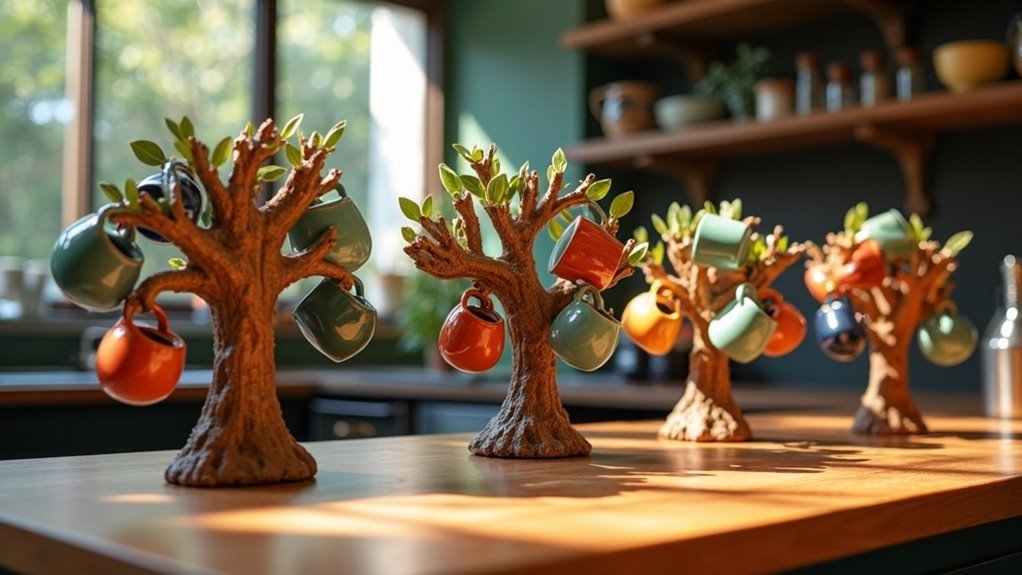The Java coffee varietal, which traces its roots back to Ethiopia and was introduced to Indonesia by Dutch traders in the 17th century, is celebrated for its floral sweetness and adaptability. Renowned for its high cup quality, Java thrives in volcanic soil, offering a distinct flavor profile that benefits smallholder farmers. Additionally, this varietal’s partial resistance to coffee berry disease enhances its resilience in various climates. For coffee enthusiasts, further exploration reveals insights into its cultivation practices and unique brewing techniques that elevate the Java coffee experience.
Key Takeaways
- The Java varietal originated in Ethiopia and was introduced to Indonesia by Dutch traders in the 17th century, becoming essential for coffee cultivation.
- Known for its floral intensity and sweetness, Java coffee often has flavor notes reminiscent of peach due to volcanic soil cultivation.
- Java exhibits partial tolerance to coffee berry disease, enhancing its adaptability and resilience in various environments.
- Sustainable farming practices and Fair Trade certification support Java farmers, ensuring ethical sourcing and better prices for their produce.
- Brewing Java coffee requires a medium grind size, an optimal water temperature between 195-205°F, and a coffee-to-water ratio of 1 to 2 tablespoons per 6 ounces.
Origins of the Java Varietal
The Java varietal of coffee, originating from Ethiopia, carries a rich history that has profoundly shaped the global coffee trade.
Introduced to the Indonesian islands by Dutch traders in the 17th century, this Typica varietal became a cornerstone for coffee cultivation. As breeders focused on enhancing its traits, smallholder growers embraced Java for its distinct flavor profile.
Introduced by Dutch traders in the 17th century, Java blossomed into a cornerstone of coffee cultivation, celebrated for its unique flavor.
However, a natural mutation in Sumatra led to the development of larger beans, deviating from the original strain.
In the 1980s, Java was introduced in Cameroon, demonstrating its partial tolerance to coffee berry disease (CBD) and further expanding its significance in diverse coffee-growing regions.
Historical Significance of Sumatran Varietals
Understanding the historical significance of Sumatran varietals reveals their deep roots and unique contributions to coffee culture. Their origins trace back to Java and Ethiopia, shaping distinctive flavor profiles that have captivated coffee enthusiasts.
Additionally, examining cultivation practices and the challenges faced by farmers underscores the resilience and adaptability of these varietals in diverse environments.
Origins of Sumatran Varietals
While exploring the origins of Sumatran varietals, you’ll uncover a narrative woven into the fabric of global coffee cultivation that dates back to the 18th century.
Key points include:
- Sumatran varietals were the first Arabica introduced to Brazil via Dutch colonization, marking a significant step in coffee’s global spread.
- Java, a Typica strain, arrived from Ethiopia through Dutch traders in the 19th century, further diversifying coffee options.
- A natural mutation in Sumatra created larger beans, leading to a divergence from the traditional Java strain and showcasing the region’s unique agricultural innovations.
- Java’s partial tolerance to coffee berry disease was recognized when it was introduced to Cameroon in the 1980s, highlighting the importance of genetic diversity in coffee cultivation.
These historical threads underscore Sumatra’s significant impact on coffee cultivation worldwide, illustrating how this region has shaped the coffee we enjoy today.
Unique Flavor Profiles
How do the unique flavor profiles of Sumatran varietals reflect their rich historical significance in the world of coffee?
The Java varietal, introduced to Sumatra, showcases a distinct floral intensity and sweetness, reminiscent of peach, which stems from meticulous cultivation practices. This Arabica coffee’s high cup quality emphasizes the connection between the volcanic soil of the region and the development of its vibrant flavors.
As the first Arabica varietal brought to Brazil, Java’s evolution highlights its resilience, benefiting smallholder farmers who depend on its unique characteristics for their livelihoods.
This combination of elements illustrates how Sumatran varietals not only enrich the global coffee trade but also embody the historical interplay of regions, climates, and agricultural practices that shape the coffee we enjoy today.
Cultivation Practices and Challenges
The cultivation practices for Sumatran coffee varietals, particularly the Java strain, highlight the intricate relationship between agricultural techniques and environmental factors that have influenced their historical importance in the coffee industry.
Key elements include:
- The introduction of Java coffee to Brazil, which has enriched its genetic diversity.
- A natural mutation of the varietal that leads to the production of larger beans.
- Enhanced resilience against coffee berry disease (CBD), showcasing its adaptability.
- Smallholder growers experiencing improved quality and better adaptation to changing conditions.
These aspects illustrate how the Java varietal not only mirrors historical agricultural shifts but also fortifies the coffee industry by fostering resilience and sustainability among growers, much like Ethiopian landrace varieties.
Adaptation of Java Varietal
As you explore the adaptation of the Java coffee varietal, you’ll notice its remarkable resilience in varying environments, particularly in places like Brazil and Central America.
The smaller beans, while different from their Sumatran relatives, develop a unique floral intensity that enhances their flavor profile.
This adaptation process, supported by extensive collaboration with agricultural experts, hasn’t only improved the quality of Java coffee but also expanded its potential in challenging growing conditions, making it a favorite among coffee enthusiasts worldwide.
Environmental Adaptation Observations
While many coffee varietals struggle to acclimate to new environments, the Java varietal has shown impressive adaptability, particularly in regions like Fazenda Ambiental Fortaleza and Sitio Canaã.
Key observations include:
- Smaller bean size compared to Sumatran counterparts
- Pronounced floral intensity in cupping
- Partial tolerance to coffee berry disease (CBD)
- High cup quality appreciated by smallholder farmers
Originally from Ethiopia, Java’s successful cultivation in diverse climates highlights its resilience.
Introduced to Central America in 1991, Java’s environmental adaptation efforts continue to enhance its quality, ensuring it thrives in various growing conditions while supporting local farmers.
This adaptability makes Java a unique choice for coffee enthusiasts seeking a distinctive flavor profile and quality in their brews.
Flavor Profile Development
When exploring the flavor profile development of the Java varietal, you’ll discover a captivating evolution influenced by its unique growing conditions and processing methods.
Java coffee showcases distinct flavor characteristics, highlighted by sweet notes of peach that are beautifully balanced with chocolate and cream undertones. This exceptional cup quality stems from its adaptability to various environments and its resilience against coffee berry disease, especially when nurtured by smallholder farmers.
The double fermentation process plays a crucial role in enhancing complexity, as flavors mature through cherry fermentation followed by pulping.
Renowned regions like Fazenda Ambiental Fortaleza and Sitio Canaã exemplify how these elements contribute to Java’s rich and layered flavor profile, making it a delightful choice for coffee enthusiasts.
Flavor Profiles of Java Coffee
Java Coffee boasts a distinctive flavor profile that captivates coffee lovers with its mild and smooth taste. Its unique characteristics are shaped by volcanic soil, resulting in an intriguing balance of flavors.
You’ll find:
- Earthy undertones that ground the coffee’s profile
- Floral aromas reminiscent of jasmine and lavender
- Nutty nuances, including hints of almond and walnut
- Notes of dark chocolate, complemented by subtle sweetness
With its medium body and gentle acidity, Java Coffee presents a complex yet harmonious experience, making it an exceptional choice for those seeking depth in their cup.
Enjoy the journey this coffee offers!
Types of Java Coffee
Exploring the diverse types of Java Coffee reveals the rich heritage and cultivation practices that shape its unique flavors. Primarily derived from the Typica varietal, Java Coffee includes distinct types like Java Ijen and Preanger Green Coffee Beans. The Ijen beans, grown in volcanic soil, offer a flavor profile of dark chocolate and citrus, making them a favorite among coffee enthusiasts. On the other hand, Preanger beans are celebrated for their velvety body and balanced acidity, providing a smooth and enjoyable drinking experience. Additionally, Robusta Java Green Coffee Beans provide a bolder taste with higher caffeine content, appealing to those who prefer a stronger brew. Each type reflects the unique environment of its origin, contributing to Java Coffee’s overall smooth and rich taste.
| Type | Flavor Profile | Origin |
|---|---|---|
| Java Ijen Green Beans | Dark chocolate, citrus hints | East Java |
| Preanger Green Beans | Velvety body, harmonious acidity | Preanger region |
| Robusta Java Green Beans | Bold, higher caffeine content | Fertile volcanic soil |
Brewing Techniques for Java Coffee
How can you fully appreciate the nuanced flavors of Java Coffee? Mastering the right brewing techniques is essential for ideal flavor extraction. Here are some key tips:
- Use a medium grind size for methods like pour-over and French press to ensure optimal extraction of flavors.
- Heat filtered water to a temperature range of 195-205°F (90-96°C) to create the perfect brewing environment.
- Stick to a coffee-to-water ratio of 1 to 2 tablespoons of coffee per 6 ounces of water for balanced strength.
- Pour hot water in a circular motion over coffee grounds to ensure even saturation and extraction of the rich flavors unique to Java Coffee.
Sustainability and Fair Trade Practices
While many coffee varieties are produced under varying standards, the sustainability and fair trade practices associated with Java coffee truly stand out for their commitment to ethical sourcing.
Java coffee is sustainably sourced, emphasizing quality while benefiting both farmers and the environment. As a Fair Trade Certified product, it guarantees growers a minimum price of $2.09 (FOB)/lb, which is essential for supporting their livelihoods.
The cultivation process prioritizes sustainable farming techniques that enhance environmental health and support local communities. Furthermore, Java coffee’s dedication to B Corp certification showcases its adherence to high standards in social and environmental performance, making it a responsible choice for conscientious coffee lovers.
Resources for Coffee Farmers
As coffee farmers encounter various challenges, having access to reliable resources is crucial for improving their cultivation practices and achieving overall success.
Here are some essential resources for coffee farmers:
- Coffee Variety Catalog: This catalog provides a selection of coffee varieties, particularly from Ethiopia, along with guidance on which varieties are best suited for different growing conditions.
- Research and Development: Focused on enhancing resistance to coffee berry disease (CBD) and improving overall crop resilience, this initiative supports farmers in adopting better practices.
- Membership Options: By joining, farmers gain access to ongoing support, valuable updates, and insights into best practices for coffee cultivation.
- Contact Information: Farmers can easily reach out for assistance through accessible email and phone support, ensuring that smallholder growers have the help they need.
These resources are designed to empower coffee farmers, especially in regions like Cameroon, providing robust support to enhance their agricultural endeavors.








